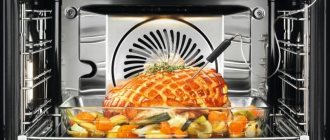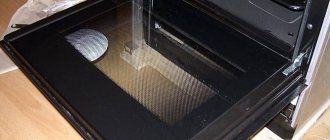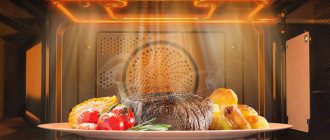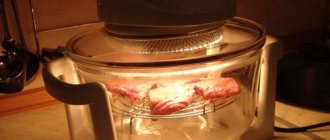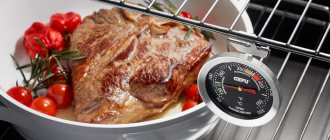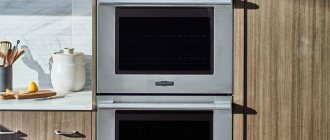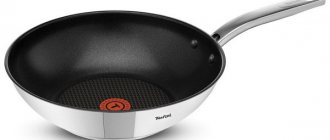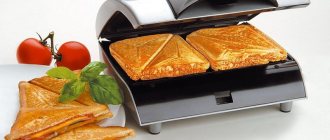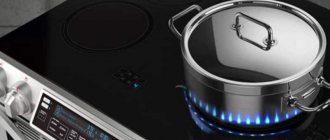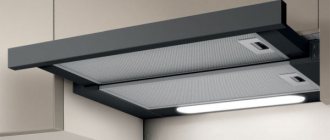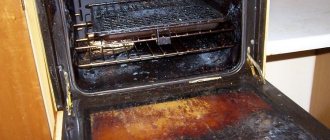Modern household appliances for the kitchen can perform a huge number of functions. Unfortunately, some of them, after purchasing a “sophisticated” oven or electric stove, remain unclaimed, but at the same time significantly increase the cost of the purchase. According to many, when buying a new oven, you should pay attention to the presence of a useful and even necessary operating mode - convection. Let's talk about what it is - convection in the oven, and why it is needed.
How the oven works
If your kitchen has a regular old model gas stove, then in its oven everything is arranged in such a way that it couldn’t be simpler: there are one or two burners located below, above which you can install shelves with baking sheets at different heights.
Heating occurs only from below, the upper part of the baked product is browned only in natural convection mode. By the term we mean the movement of heated air masses, accompanied by heat exchange.
In such an oven, this very often happens: on the one hand, on the far wall, the pies or roast have already begun to brown and burn, and the part located closer to the door has not even browned yet. You have to take out a baking sheet or pan and turn it over to even out the heat.
But not all types of tests can withstand such manipulations without consequences. For example, your sponge cake may well fall off. There is no need to talk about capricious meringues - baking meringues requires a very gentle regime so that the delicate protein foam does not settle.
A more modern gas stove may also have a top burner in the oven. Sometimes the top heating element may be electric and the bottom burner may be gas. Having an additional heat source greatly simplifies the cooking process. You can adjust the heat in the oven from above and below if necessary.
Even not the latest models of electric ovens have more than one heating element. But their presence does not ensure high-quality, uniform baking of the prepared products.
This happens because natural convection in a household oven occurs slowly and depends on other factors. For example, on the width of the baking tray placed. So if there are no gaps left on the sides, heated air from the bottom of the oven simply will not get into its upper part. In this case, the lower surface of the dough is doomed to burn, and the upper surface will remain unbaked.
And then a forced mode comes to the rescue - the convection mode. This is exactly the function that home appliance sellers praise so much when they offer you to buy an electric oven .
Electric
There is a generally accepted opinion that electric ovens bake better than gas ovens. This is true. This can be explained simply by the difference in design. In gas models, there is only one heat source - a burner located at the bottom of the chamber.
And in electric ones there are at least two, with one heating element heating from above, and the other from below, thereby ensuring uniform baking of the product. However, if you put two pies at once on different levels in such a cabinet, they will not bake equally. One will fry more strongly on top, the other on bottom, depending on which side is closer to the heating element.
Gas
As mentioned earlier, a gas cabinet only has one burner at the bottom, so even heat distribution is more difficult to achieve. First of all, they try to reduce heat loss by wrapping the chamber with insulating and reflective materials. Seal the gaps between the chamber and the door, installing 2-3 glasses in the latter.
Surely many housewives have noticed that there are holes made along the edges of the baking sheets. This is necessary so that the metal sheet does not interfere with the passage of heat, and it flows freely to the top. However, despite all these tricks, it is not always possible to achieve good baking.
This can be partly explained by the peculiarities of cooking with gas. During operation, combustion products are formed that must be removed. Therefore, in principle, the chamber in the oven cannot be sealed, and, therefore, heat loss cannot be avoided.
Convection in the oven
From the point of view of physical understanding, convection is a process of a special type of heat exchange, during which thermal energy is distributed through air flows or jets of other matter. Literally translated from Latin, the word means “transfer.” If we talk about kitchen appliances, then in the oven the most important criterion is the heating speed and uniform heat distribution. The quality of baked goods or other dishes whose recipes involve baking in the oven will depend on this.
FOR YOUR INFORMATION!
(click to find out)
Further development of household appliances led to the appearance of the convection function in the oven. What does it mean? Each new oven began to be equipped with several heating elements, which could be placed not only on top or bottom, but also on the sides, and the appearance of a fan can be considered an additional innovation. Its purpose is to force heat to spread throughout the entire internal area of the cabinet. Thus, there is a uniform distribution of thermal energy, which has a positive effect on the quality of cooking.
FOR YOUR INFORMATION!
(click to find out)
What is convection in an oven
Convection is the transfer of heat by air currents. It is a Latin word that means "transfer." In simple terms, convection is when warm and cold air change places, the warm air rises and the cold air sinks.
Eventually, all layers mix and the temperature becomes the same everywhere. Perhaps someone remembers old ovens, in which the baking sheet had to be placed on the lower level first, and then raised higher so that the food did not burn from below.
So, in convection ovens there is no need to perform such manipulations. The heat will be evenly distributed immediately after heating, and the delicious pies will not burn. They will be cooked through in the middle and crispy on top, without being soggy or overcooked.
Moreover, you can put two or three baking sheets in one oven at the same time and even cook several dishes at once. Truly, this is the dream of every housewife. You save time, energy and have time to get everything done.
In older oven models, burners (gas) or heating elements (electric) were located only at the bottom, and the top of the baked goods was browned due to natural convection - the movement of heated air and heat exchange in the closed space of the oven.
The results were often disappointing: the bottom was burnt and the food was unevenly baked. I had to take out the baking sheets, turn them in different directions, and place a container of water on the bottom of the oven.
New oven models, as a rule, are also equipped with heating from above, which greatly simplifies the baking process and allows you to cook dishes on the grill. But even with combined heating (bottom and top), natural convection may not be enough for perfect baking.
The fact is that normal heat exchange in the oven occurs rather slowly; certain factors can interfere with it: a door that does not close tightly or opens it frequently, as well as large baking sheets that occupy the entire width of the oven and interfere with air circulation.
Convection (from Latin convectio - transfer) is a natural heat exchange in which internal energy is transferred by flows and jets. Warming air rises and cold air falls down.
In an oven, when layers of air are mixed more quickly due to convection, the temperature immediately becomes the same on all levels. Now any housewife can appreciate the advantages of ovens with forced convection, that is, air circulation created using a built-in fan.
It is usually located on the back wall of the oven and turns on separately when certain modes or preset programs are selected.
Various oven manufacturers offer improved convector designs that have additional features: fans with a separate heating circuit, reinforced fans to create a rapid flow of hot air, moist convection mode for steaming dishes without the use of fats.
What is forced convection
In this case, this means forced air circulation in the oven. The movement of hot air masses is provided by a fan.
In the closed space of the oven, the airflow creates a real vortex of hot air. This vortex evenly heats the product from all sides. Nothing else burns on the bottom; the top is covered with a beautiful crispy crust.
The fan is usually located on the back wall of the oven and is turned on separately.
Convector in this case means forced air circulation mode in the oven. The movement of hot air is provided by the ventilation element. In the closed space of the oven there is a real hot air blowing system.
- Convective heating while a dish is being cooked in the oven heats it up equally on all sides, therefore:
- nothing burns from the bottom;
- a magnificent fried crust forms on top;
- the dish will be completely cooked.
The forced convection system is usually located on the back wall of the oven. The fan can be turned on separately and prepare properly delicious baked dishes. After the end of cooking, the timer usually beeps, giving a signal.
Why do you need convection in the oven, or the Pros and cons of this option
To understand whether convection is needed in an electric oven, you need to find out what positive and negative aspects the stoves equipped with this option have. Some housewives in reviews on forums indicate that they cannot cope with the process of forced heat distribution. But most of the women who dominate the kitchen note that using a convector in the oven greatly simplifies the preparation of many dishes.
IMPORTANT ! (click to find out)
The advantages that a convector in an oven provides (and this is noted not only by ordinary housewives, but also by experts in the field of kitchen appliances) are:
Despite the abundance of advantages, when figuring out whether convection is needed in the oven, one cannot help but note one disadvantage, which for many can be decisive. Convection stoves are distinguished by a higher cost than simple models that do not have a useful option.
Otherwise, for representatives of the fair sex who love to be in the kitchen, do it often or if they have a large family, experts recommend choosing convection ovens.
What is convection in the oven for?
It allows you to successfully bake large pieces of meat, bake wonderful pies, make delicate meringues and even simply dry herbs, delicious candied fruits or crackers. You can even skip the heat by using just cold convection. And in combination with low heat, convection will allow you to quickly defrost meat or vegetables from the freezer.
The convection mode will allow you to use the entire volume of the oven with maximum efficiency: even if you put two or three baking sheets inside, everything will bake evenly.
- It is not necessary to use this function every time you cook. It can be turned on in cases where it is really necessary:
- to ensure a crispy crust;
- to dry out too much liquid released from baked products;
- for good baking of a large pie or poultry carcass.
The modern convection oven has various baking, grilling and defrosting modes. This allows you to cook several dishes at the same time, which significantly reduces gas (electricity) consumption and the amount of cooking time.
Detailed instructions from the manufacturer tell you how to configure the necessary parameters. So, convection is a function in which forced air circulation occurs inside the oven, due to which the same heating temperature is formed on all sides.
- To understand whether convection is needed in the oven, let’s look at the advantages of this function:
- Uniform temperature. Dishes are baked on all sides at once.
- Cooking several dishes at the same time.
- Replaces hobs. In some cases, such an oven allows you not to use standard hobs (in the country, in country houses, etc.).
- Minimizing electricity and gas consumption.
- Additional modes - for baking, defrosting, drying.
- Full control and security. You can always turn off the blowing function yourself.
Advantages
Many people ask why the convection mode is needed if meat is baked perfectly in the oven without it? Why turn it on and what dishes to cook with it? This question was partially answered in the previous section.
- A convection oven has a number of advantages:
- the dish is baked evenly;
- you can cook food on several baking sheets at once;
- you can do without a hob;
- less electricity or gas consumption;
- less oil consumption;
- The range of dishes that you can cook in the oven is expanding.
In the oven, meat and fish are defrosted with a stream of hot air, medicinal and spicy herbs are dried, nuts and lemon zest are dried. The oven makes excellent meringues and various pastries made from dough. If convection is not needed, then the mode is simply not turned on.
Indeed, how many times have housewives been faced with a situation where it is necessary to cook both a side dish and meat at the same time? And when you have to bake a cake from several layers? In the latter case, cooking was delayed for several hours: first the first cake was placed, when it was baked - the second, then the third, and so on.
It was only a dream to cook several cakes at the same time on different levels. In a convection oven, you can spread the dough on several baking sheets, and it will bake equally well on all of them.
Why else should you choose a device with convection? Not everyone knows that convection can be used to dry berries and herbs. How did you usually dry it in ovens before? We laid out the food on a baking sheet, turned on the minimum heat, and opened the door.
To prevent the berries from burning, you had to stir them regularly and monitor the temperature. If you use convection in the oven, everything becomes much simpler. The fan blows the greens and berries evenly, as a result they dry quickly and do not burn.
In this case, the upper and lower heaters do not need to be turned on at all - the convector is often adjacent to an additional low-power circular heating element, which is turned on together with the fan.
In ovens, convection is often combined with other heating methods. The more expensive the model, the more functions it has, the more combinations for preparing a variety of dishes it can have.
Types of convectors
Most often, your electric oven is provided with this opportunity by a fan of a simple design, the function of which is simply to drive air throughout the entire volume of the oven. A fan surrounded by an additional heating circuit is more efficient.
Some models of Miele electric stoves have a convenient wet convection function. When this mode is turned on, the air inside the oven is saturated with steam. Dishes don’t dry out, the dough rises better, and you can generally steam anything you want without harmful frying.
In Neff brand cabinets, manufacturers build in reinforced fans that create a rapid flow of hot air. Rapid heating gives a good effect in autumn: the product is quickly covered with a dried layer, which prevents the juices from evaporating during further baking.
All of the above applies to electric ovens. Until recently, the usual gas stove was deprived of a convenient forced mode.
But recently the Electrolux company launched a new product on the market: now a gas stove can be equipped with a fan. For now, only a free-standing gas stove can have this function, but it is not a fact that manufacturers will stop developing new models.
The fact is that a gas stove still outsells an electric one, at least when it comes to free-standing stoves. And the Russian market is no exception.
Gas in our country is still cheaper than electricity. Therefore, a gas stove is used in 80 out of 100 kitchens. Now those for whom a gas stove is more suitable will also be able to appreciate a gas oven with convection.
So, there are three popular types of stoves that are equipped with convection:
- Type 1. Gas stove + electric convection
- Several features of a gas stove with this function:
- Gas + electricity. Most often, models are produced in which the hob is powered by gas, and the oven is powered by electricity.
- Price. The cost of such a device is usually higher than one that runs entirely on electricity.
- Safety. When forced air circulation is operating, the gas supply is turned off.
- Type 2. Electric
On store shelves you can find a mini-sized electric oven. This is a fairly compact device that works when connected to the network.
An electric stove has limited space, so it can be difficult to cook several dishes inside at once.
- Type 3. Combined
Manufacturers are increasingly releasing models with mixed mode operation. This design allows you to cook with both electricity and gas.
How it works
In the oven, convection mode is possible thanks to the installation of a fan. It is the fan that moves and mixes layers of air. This mixing ensures the same temperature throughout the entire volume, as a result of which the dish is baked or fried evenly.
Most often, the fan is installed on the back wall of the oven. It circulates air, distributing heat evenly. When the desired internal temperature is reached, the fan turns off. Oven models are produced in which an additional heating circuit is installed around the fan. Due to this, the efficiency of the oven increases even more.
Electric convection ovens have dozens of functions that allow you to cook different dishes, defrost food, grill, and combine modes.
You yourself can choose the desired mode for the dish, depending on what the recipe requires and what result you want to get.
After reading the instructions, it is very easy to understand the control system. You can adjust the temperature, set the cooking time and the direction of the convection flow. Each function has its own icon.
Thus, cooking using convection with upper and lower heating turned on is indicated in the form of a stylized screw between two horizontal stripes.
Applying modes
At low temperatures (up to 150 ℃) or even without heating in convection mode, you can quickly and carefully dry fresh herbs, pieces of citrus peel, nuts, mushrooms or fruits (in particular, for uzvar - pre-peeled and cut into small flat pieces). Cold convection can also be used to defrost food.
At medium temperatures (160-220 ℃), convection provides an intense and impressive rise of products from most types of dough: yeast, sponge, shortbread, puff pastry, choux. With it you will get airy and dry inside eclairs, tender and light meringues, baked and rosy muffins.
An undoubted advantage of convection is the ability to use the entire volume of the oven to simultaneously prepare different dishes on several baking sheets.
When using the convection mode in the oven at high temperatures (from 220 ℃), large pieces of meat or poultry will retain internal juiciness, they will have a crispy crust, they will bake and fry evenly.
It is effective to use convection for drying juice if it is released in too large quantities, as well as for preparing dishes in portioned or large dishes, for example, in ceramic pots or a casserole dish.
The main differences between wet convection, enhanced and dry
- Type 1. Forced dry circulation.
The oven contains one or more fans, which may be surrounded by additional heating circuits.
- Type 2. Wet circulation.
In addition to the usual blowing, the air is saturated with moisture, thanks to which you can steam dishes.
- Type 3. Increased circulation.
A powerful fan creates a rapid flow of air, which allows the crust to set quickly and the inside of the food to remain juicy.
There should be a corresponding pictogram on the panel of both gas and electric stoves. It usually looks like a three-blade fan.
- Descriptions of other icons:
- Fan with underscore – blowing from below.
- With a zigzag on top - blowing + grill.
- Eco - wet circulation.
Convection mode indicators
The main differences between wet convection, enhanced and dry
- Wet circulation. With this technology, in addition to the usual heating of the air, it is also actively saturated with moisture. This makes this convection ideal for steaming dishes.
- Increased circulation. The main detail in this case is a reinforced powerful fan. Perfect for those cases when you need to achieve a crispy crust on the surface of the dish.
- Forced dry circulation. In this case, the oven contains several fans, which also often have additional heaters.
The most useful programs
- Normal convection. Used for heating dishes, preparing dough before baking, drying herbs, berries and fruits.
- Convector, bottom heater and grill. This is the optimal mode for cooking semi-finished products.
- Convector and bottom heater. This mode is ideal for baking pizza, pies, and bread.
- Turbo grill. When this mode is turned on, the top heater, convector and grill are activated immediately. Good for cooking large pieces of meat.
All of these modes, except regular convection, should be used for a baking tray set at the same level.
Double convection
There are also models on the market with two convectors installed simultaneously. The main brand that produces such ovens is Samsung. The presence of two fans allows you to distribute and warm up the air masses much more efficiently.
Before purchasing equipment with this function, you should make sure that such a choice will be justified. The presence of this function significantly increases the cost of the equipment. The choice is appropriate if you plan to regularly prepare dishes in this mode.
Application of humid convection
Ovens in wet convection mode are used for steaming various meat, vegetables and other dishes. The design of ovens with a similar mode consists of the following elements: a fan, a special container for water and a generator that converts water into steam.
Convection mode in oven icon
If you bought an oven and never looked at its instructions, you can find out whether you have convection in the oven by looking at the icons and symbols on the control panel.
Depending on the oven model, the modes may vary depending on the combination of convection with the available heating options and the presence of steam.
The standard designation of convection modes includes a “fan” icon and a mark indicating the inclusion of individual heating elements (combined, selective - upper element only, lower element only, convection only).
Ovens with moist convection deserve special attention. They have built-in containers on the front or back wall, into which clean water is poured, and a steam generator.
In the humid convection mode, products are blown from all sides not just with evenly hot air, but with steam, which significantly speeds up the cooking process, helps maintain the juiciness of dishes, and reduces the amount of salt and fat. (A dream for all adherents of dietary and healthy eating!)
The most advanced models provide humidity control in several modes: hot steam (25%), intense steam (50%) and wet steam (100% - steamer mode). In this case, the moment of steam supply is automatically calculated by the program itself, but its quantity and frequency can be controlled manually.
There are options for different directions of the steam jet: distribution throughout the oven, on the dishes or on the products themselves through a special tube. Moist convection modes are convenient for sterilizing cans or baby food bottles. Convection in the oven is one of the indispensable functions of modern kitchen equipment.
It really expands your capabilities and provides enormous scope for culinary experiments. Now many traditional recipes are being revised taking into account new technological capabilities and are being adapted for convection ovens.
There is an opinion that convection in the oven allows you to reduce the temperature required for different types of baking by 10-15 ℃. Prepare your favorite dishes in a new way, come up with original recipes, make yourself and your loved ones happy!
The most useful programs
Normal convection. It is used for heating plates for the holiday, preparing (raising) dough before baking. Used for drying berries, herbs, sliced fruits and vegetables. It can also be chosen for baking juicy, minimally cooked foods suitable for dietary needs.
- A convector is useful if you need to defrost a large amount of food that will not fit in the microwave oven, for example, a Christmas turkey.
- Convector and bottom heater. This mode is used for cooking pizza, bread, pies. The main heat comes from below, baking the dough, and the hot air melts the cheese.
- Convector, bottom heater and grill. The mode is optimal for preparing frozen foods, including semi-finished products. This combination of heaters allows you not only to bake food, but also to form a golden brown crust on their surface.
- Turbo grill. In this mode, the convector, top heater and grill are turned on. Used for frying large pieces of meat, baking a crust on food.
It should be clarified that all of these modes, except the first, involve cooking at only one level. If you install several baking trays in the oven, the effectiveness of the combinations decreases.
Double convection
There are models in which two convectors are installed, located one above the other. This design is found in Samsung ovens, for example, Samsung BTS14D4T. Two fans distribute air more efficiently than one.
If in models with one convector the pies on different levels may turn out to be baked differently (on the middle tier the airflow is more intense, on the lower one less), then with two this problem will not arise. Each fan blows at its own level, so the food is baked at the same time.
It should be clarified that a convection oven should be purchased if the owner will regularly cook in this mode, since this function significantly increases the cost of the equipment.
Application of humid convection
Those who adhere to a healthy diet will be interested to know that some oven models have a moist convection mode. What is it for?
This mode allows you to steam food while preserving nutrients. Hot steam is supplied to the oven, so the food is not overcooked. It remains juicy and soft inside. The most famous brands offering such equipment are Electrolux, Miele, Smeg, Hansa.
In order for the wet convection mode to work in the oven, you need to pour water into a special container on the door or on the back wall. Once turned on, the water enters the steam generator and within a few minutes it will fill the oven.
- The important thing is that the steam jet can be directed in different ways:
- distributed throughout the entire volume of the oven;
- gets into the dishes;
- goes directly to products.
The steam jet supply time can be controlled. Using the wet convection mode, fish and vegetables are baked very tasty, you can prepare puff pie with a golden crust, heat up dishes, and sterilize jars and bottles for baby food.
Why do you need convection in an oven, or Features of the function for different types of stoves
What is convection in an electric stove oven
Some housewives ask a very reasonable question about how much convection is needed in an electric oven, which is considered the most powerful of all types and can heat up to a temperature of 300°C. In fact, the use of a convector is necessary to obtain an even distribution of warm air. Despite the presence of several heating elements and high power, it is not always possible to achieve complete baking without burning. The reasons for this may be:
- slow speed of natural convection;
- baking pan thickness;
- different density of food products.
In order for the finished dish to be fried and the baked goods to have a golden crust, you cannot do without a convector. Therefore, models of electric stoves with this option are the most popular on the market.
Convection microwave speeds up the cooking process
Since more energy is consumed when the fan is running, if you have an electric stove equipped with a convector, before installing it you should check the reliability of the wiring to prevent a short circuit.
What is convection in a gas stove
Gas stoves with convection ovens have their admirers, which is primarily due to the relative cheapness of this type of fuel. Modern stoves that run on gas and are equipped with a convector are no different in appearance from their conventional “brothers”. The only difference is the presence of a fan built into the rear wall.
The convector used in a gas stove has its own operating characteristics. Since in such models the heating part is located only at the bottom, to obtain the required temperature you need to run the convector for a while and only then load the dish into the oven. A significant disadvantage of gas models is the lack of complete sealing of the oven, since the constant removal of combustion products is required. This leads to an increase in cooking time, creating additional problems for the housewife.
Gas oven requires preheating to a certain temperature by convection
Convection grill - what is it?
Modern stoves are often equipped with additional options, such as a grill function. Its presence allows you to cook a piece of meat on a spit, as if plunging into the depths of centuries, when ancestors cooked their food over a fire. There are two types of grill:
- gas, which creates the full feeling of cooking over coals;
- electric, characterized by more convenient operation.
The presence of a grill does not mean the absence of convection. On the contrary, these two modes complement each other perfectly. If there is a convector in the stove, there are two grill modes:
- air fryer;
- turbo grill.
The corresponding mode is activated by pressing the desired button on the control panel. A special feature of using an air fryer is the ability to obtain juicy meat with a crispy crust due to the uniform heating of the entire surface of the dish.
Grill plus convection - a win-win combination
A turbo grill is required when there is a need not only to completely bake a piece, but also to do it quickly. Its main task is to activate all heating elements present in the stove and all fans.
The presence of a gas grill with an electric oven with convection function provides a unique opportunity to simultaneously cook two dishes.
What is convection in a microwave oven
The microwave has become familiar to every family, since this household appliance allows you to quickly heat small portions of food or defrost food. At its core, a convector installed in a microwave oven is no different from a similar device in a standard oven, except in size. A small fan leads to the distribution of air flows inside the chamber. When certain temperature parameters are reached, automatic shutdown occurs. Using a convection microwave allows you to reduce the cooking time by about half.
An alternative to a microwave oven can be a compact tabletop electric oven with a convection function. This will allow you to cook dishes no worse than on a conventional stove, but will help save money and space.
A tabletop mini-oven with a convector allows you to save money and free kitchen space
Features of gas ovens
Gas ovens with a fan are produced less frequently and are usually more expensive. But the savings when operating such devices are obvious. You can use gas, which is cheaper, plus the convection mode allows you to further reduce costs.
Among the companies producing gas ovens with an air mixing function are Zanussi, Kaiser, and Korting OGG.
The peculiarity of gas ovens with convection is that safety measures must be observed. The design of the device must be such that when the flame is blown out, the gas is turned off. Manufacturing companies have taken care of safety, so you can safely buy household appliances.
